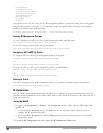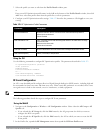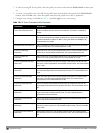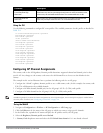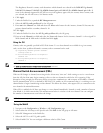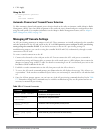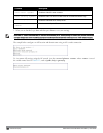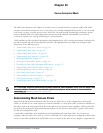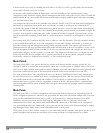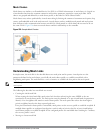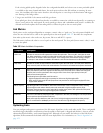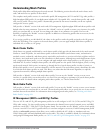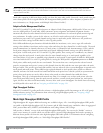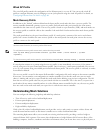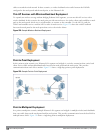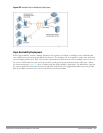
440 | SecureEnterpriseMesh DellPowerConnectW-SeriesArubaOS6.2 | User Guide
to deliver mesh services only (by disabling the mesh radio in its 802.11a or 802.11g radio profile) that mesh node
can not deliver WLAN services to its clients.
For mesh as well as traditional thin AP deployments, the Dell controller provides centralized provisioning,
configuration, policy definition, ongoing network management and wireless and security services. However, unlike the
traditional thin AP case, mesh nodes also perform network traffic encryption and decryption, and packet forwarding
over wired and wireless links.
You configure the AP for mesh on the controller using either the WebUI or the CLI. All mesh related configuration
parameters are grouped into mesh profiles that you can apply as needed to an AP group or to individual APs.
By default, APs operate as thin APs, which means their primary function is to receive and transmit electromagnetic
signals; other WLAN processing is left to the controller. When planning a mesh network, you manually configure APs
to operate in mesh portal or mesh point roles. Unlike a traditional WLAN environment, local mesh nodes provide
encryption and traffic forwarding for mesh links in a mesh environment. Virtual APs are still applied to non-mesh
radios.
Provisioning mesh APs is similar to thin APs; however, there are some key differences. Thin APs establish a channel
to the controller from which they receive the configuration for each radio interface. Mesh nodes, in contrast, get
their radio interfaces up and running
before
making contact with the controller. This requires a minimum set of
parameters from the AP group and mesh cluster that enables the mesh node to discover a neighbor to create a mesh
link and subsequent channel with the controller. To do this, you must first define and configure the mesh cluster
profile
before
configuring an AP to operate as a mesh node. This chapter first describes how to configure the mesh
profile, then describes how to configure APs to operate in mesh mode. If you have already configured a complete
mesh profile, continue to “Ethernet Ports for Mesh” or “Provisioning Mesh Nodes”.
Mesh Portals
The mesh portal (MPP) is the gateway between the wireless mesh network and the enterprise wired LAN. You
configure a Dell AP to perform the mesh portal role, which uses its wired interface to establish a link to the wired
LAN. You can deploy multiple mesh portals to support redundant mesh paths (mesh links between neighboring mesh
points that establish the best path to the mesh portal) from the wireless mesh network to the wired LAN.
The mesh portal broadcasts the configured mesh service set identifier (MSSID/mesh cluster name), and advertises
the mesh network service to available mesh points. Neighboring mesh points that have been provisioned with the
same MSSID authenticate to the portal and establish a secure mesh link over which traffic is forwarded. The
authentication process requires secure key negotiation, common to all APs, and the mesh link is established and
secured using Advanced Encryption Standard (AES) encryption. Mesh portals also propagate channel information,
including CSAs.
Mesh Points
The mesh point (MP) is a Dell AP configured for mesh and assigned the mesh point role. Depending on the AP
model, configuration parameters, and how it was provisioned, the mesh point can perform multiple tasks. The mesh
point provides traditional Dell WLAN services (such as client connectivity, intrusion detection system (IDS)
capabilities, user role association, LAN-to-LAN bridging, and Quality of Service (QoS) for LAN-to-mesh
communication) to clients and performs mesh backhaul/network connectivity. A mesh radio can be configured to
carry mesh-backhaul traffic only. Additionally, a mesh point can provide LAN-to-LAN Ethernet bridging by sending
tagged/untagged VLAN traffic across a mesh backhaul/network to a mesh portal.
Mesh points use one of their wireless interfaces to carry traffic and reach the controller. Mesh points are also aware of
potential neighbors and can form new mesh links if the current mesh link is no longer preferred or available.



